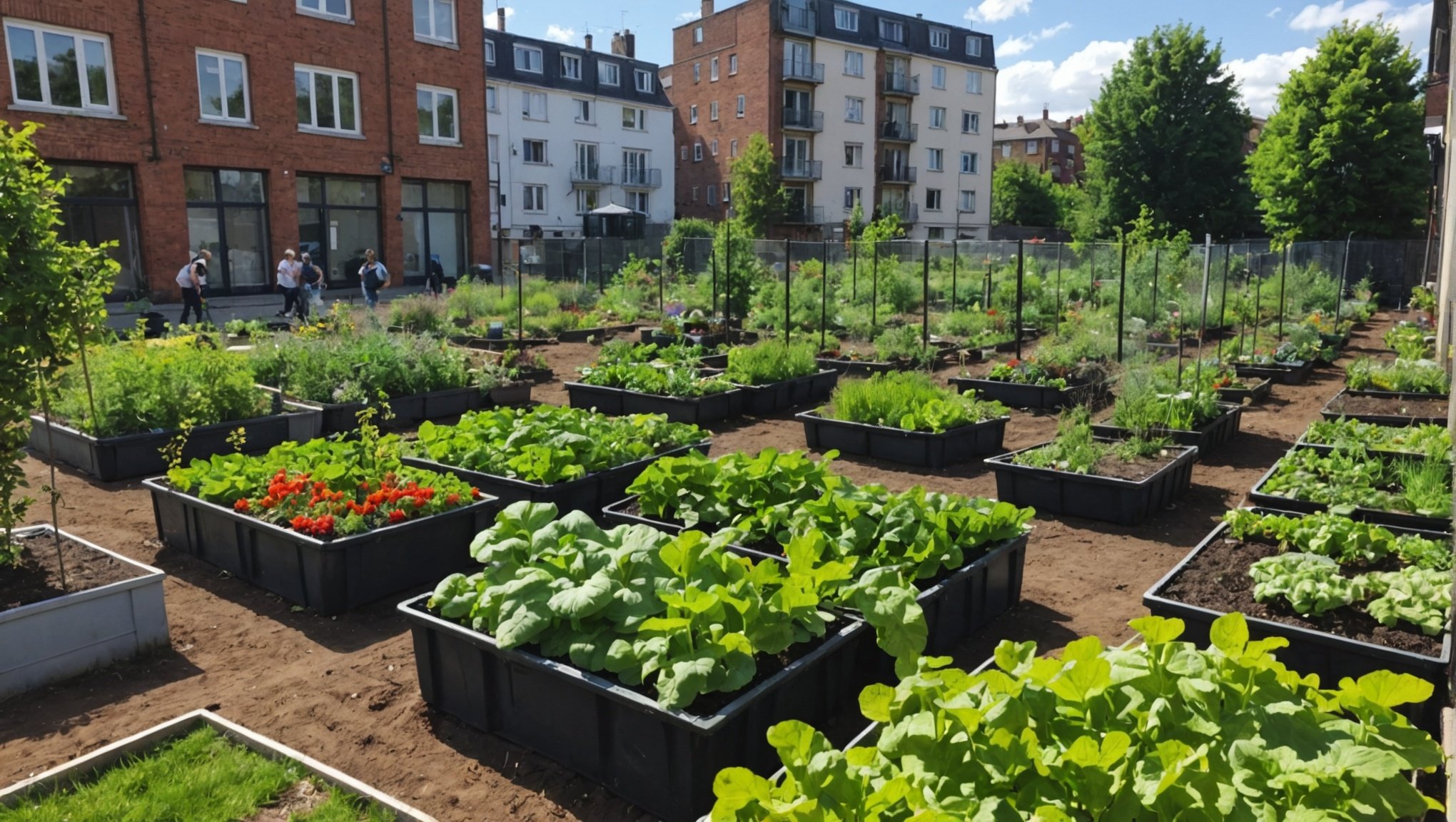Transforming Urban Lives: The Impact of Community Gardening on Mental Health and Well-being
The Power of Community Gardening
In the heart of bustling cities, where concrete and steel dominate the landscape, community gardening has emerged as a beacon of hope and wellness. This simple yet profound activity is transforming the lives of urban residents, offering a myriad of benefits that extend far beyond the physical realm. Let’s delve into the world of community gardening and explore how it is revolutionizing mental health and well-being in urban settings.
Mental Health Benefits of Community Gardening
Community gardening is more than just a hobby; it is a therapeutic activity that has significant positive effects on mental health. Here are some of the key ways in which gardening in a community setting can improve mental well-being:
In the same genre : Unlocking Emotional and Social Intelligence in Children: The Impact of Multicultural Experiences
Stress Reduction
Gardening is known to be a natural stress reliever. Studies have shown that spending even 20 minutes in green spaces can significantly reduce stress levels, improve mood, and increase an overall sense of well-being[1][3].
Improved Mood and Self-Esteem
The physical activity involved in gardening, combined with the sense of accomplishment from seeing plants grow, can boost self-esteem and improve mood. A study published on Google Scholar highlighted that frequent exposure to urban green spaces is tied to improved mood, heightened self-esteem, and overall better mental health[3].
Also to read : Unlocking Restful Nights: How Yoga Nidra Can Enhance Your Sleep Quality
Social Connections
Community gardens serve as community hubs where people from various backgrounds come together. These social interactions foster a sense of belonging and community, which are crucial for mental health. As one scholar noted, “Urban parks and gardens emerge as focal points where people from various walks of life can convene, interact, and partake in different activities, developing social connections and tightening community ties”[3].
Connection with Nature
Being in nature has long been recognized for its therapeutic benefits. Community gardening provides an opportunity for urban residents to reconnect with nature, even in the most urbanized areas. This connection can act as a remedy for feelings of anxiety, depression, and stress, thereby fostering enhanced psychological well-being[1][3].
Physical Health Benefits
While the mental health benefits of community gardening are profound, the physical health advantages are equally significant.
Physical Activity
Gardening is a moderate physical activity that helps keep individuals fit. It involves a range of activities such as digging, planting, and maintaining gardens, all of which contribute to improved physical health. Urban permaculture, for instance, promotes physical activity through gardening, helping to reduce stress and improve general well-being[4].
Access to Fresh Produce
Community gardens provide residents with access to fresh, locally grown produce. This not only improves nutritional quality but also enhances food security, particularly in disadvantaged communities. The Gotham Greens project in New York City is a prime example of how community gardens can transform vacant lots into productive green spaces, boosting the nutritional health of the community[3].
Air Quality and Urban Heat Island Effect
Green spaces in urban areas act as natural filters, removing pollutants and heavy metals from the air. They also reduce the urban heat island effect, lowering ambient temperatures and improving the living comfort of residents. These environmental benefits indirectly contribute to better physical health by creating a healthier urban environment[1].
Social Health Benefits
Community gardening is not just about individual health; it also has a profound impact on social health and community cohesion.
Community Integration
Community gardens are more than just spaces for food production; they are social hubs where residents can come together to garden, exchange ideas, and collaborate. These interactions foster social ties and a sense of belonging, integrating newcomers and promoting diversity and social cohesion[4].
Educational Role
Community gardens often organize workshops on gardening, composting, and other ecological practices. These educational activities encourage the exchange of knowledge and interaction between participants, raising residents’ awareness of environmental issues and sustainable practices. They serve as living laboratories where children and adults can learn about ecology, plant life cycles, and the importance of biodiversity[4].
Social Events and Activities
Urban parks and community gardens host various events, such as carnivals, recreational activities, and community meetings. These events encourage family excursions and interaction between different age groups, ensuring access and enjoyment by all socio-economic groups. This inclusivity supports social equality and inclusivity within the community[3].
Practical Steps to Starting a Community Garden
If you’re inspired to start a community garden in your urban neighborhood, here are some practical steps to get you started:
Step 1: Identify the Need and Location
Research the specific needs of your local community and identify a suitable location for the garden. This could be a vacant lot, a rooftop, or even a small pocket park. Ensure the location is accessible and has the necessary resources such as water and sunlight[2].
Step 2: Build a Community
Gather a group of interested residents and form a community gardening group. This collective effort will help in planning, designing, and maintaining the garden. Community gardens are about more than just gardening; they are about building social connections and a sense of community[4].
Step 3: Design and Plan
Design your green space based on the needs of your community. Include features such as walking paths, seating areas, and educational signs about local flora. Consider the types of plants that are well-suited to your local climate and soil, and think about the needs of different groups in the community—families, elderly residents, and wildlife[2].
Step 4: Engage in Gardening Activities
Once the garden is set up, engage in various gardening activities. This includes planting, maintaining, and harvesting. Encourage all members to participate, as this collective effort strengthens social ties and fosters a sense of responsibility for the shared space[4].
Examples and Case Studies
Several cities around the world have successfully implemented community gardening projects, showcasing the transformative power of these initiatives.
Gotham Greens in New York City
The Gotham Greens project in New York City is a notable example of how community gardens can transform vacant lots into productive green spaces. This project not only provides fresh produce but also fosters a stronger sense of community and a deeper connection to nature[3].
Urban Permaculture in Europe
In Europe, urban permaculture projects are gaining momentum. For instance, community gardens in cities like Warsaw and Krakow serve as educational spaces and social integration hubs, promoting local flora and its benefits while improving the quality of life for residents[1].
Community gardening is more than just a hobby or a way to grow vegetables; it is a powerful tool for transforming urban lives. By integrating green spaces into urban environments, we create healthier, more sustainable cities that benefit both the environment and the residents.
Here is a summary of the key points in a detailed bullet point list:
- Mental Health Benefits:
- Reduces stress and improves mood
- Boosts self-esteem
- Fosters social connections and community integration
- Provides a connection with nature
- Physical Health Benefits:
- Offers moderate physical activity
- Provides access to fresh produce
- Improves air quality and reduces the urban heat island effect
- Social Health Benefits:
- Integrates community members
- Offers educational opportunities
- Hosts social events and activities
- Practical Steps:
- Identify the need and location
- Build a community
- Design and plan the garden
- Engage in gardening activities
- Examples and Case Studies:
- Gotham Greens in New York City
- Urban permaculture projects in Europe
In the words of Bill Mollison, one of the founders of permaculture, “The only limit to our realization of tomorrow will be our doubts of today.” By embracing community gardening, we can create a brighter, healthier tomorrow for urban residents.
Table: Comparing the Benefits of Different Urban Green Spaces
| Type of Green Space | Mental Health Benefits | Physical Health Benefits | Social Health Benefits |
|---|---|---|---|
| Community Gardens | Reduces stress, improves mood, boosts self-esteem | Provides physical activity, access to fresh produce | Fosters social connections, community integration, educational opportunities |
| Urban Parks | Offers relaxation, reduces anxiety and depression | Improves air quality, reduces urban heat island effect | Hosts social events, encourages family excursions, supports social equality |
| Green Roofs and Walls | Provides a connection with nature, improves mood | Regulates temperature, improves air quality | Creates new habitats for wildlife, beautifies the city |
| Pocket Parks | Offers relaxation, reduces stress | Improves air quality, reduces noise levels | Integrates community members, provides educational signs about local flora |
By understanding and leveraging these benefits, we can create urban environments that are not just livable but also thriving and healthy. So, the next time you think about transforming your urban space, consider the life-changing power of community gardening.











